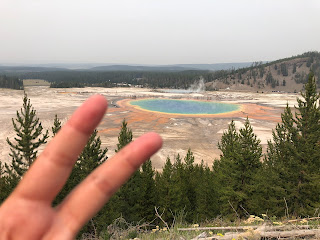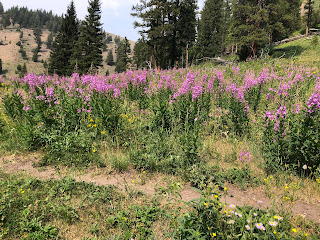Yellowstone: 2021
I am of the opinion that each American's experience at Yellowstone National Park should be unique. I planned this trip, which I took with my best college friend (a native of Idaho and a blessedly wonderful no-stress traveler like myself), over several months. For that time, memorizing maps and reviewing trails was my obsession--still is in fact, as the adventure kicked off a desire to visit more National Parks and take up hiking as a full-time hobby. Searching for the places that speak to you is important and they may not be those I record below. Take your time in the park to marvel at those areas untouched by human intervention. Put your toes in the Yellowstone river and observe black bears (from a safe distance) without a photo lens between you and them. Yellowstone is an adventure of a lifetime--enjoy every minute of it and find your solitude.
Bison in Lamar Valley, notice "red dog" calves
~A Brief Overview of Our Itinerary (Complete with Hidden Gems)~:
Familiarize yourself with a map of the park before you go. Our tour, of about three full days, focused on the Madison, Old Faithful, Norris, Canyon, Mammoth, and Roosevelt areas. There is a lot of ground to cover and drives can lengthen in traffic, so you may want to do what we did, camp at a different entrance each day. We entered from the West entrance to enjoy the Geysers, exiting in the North. Then entered at the North to enjoy Mammoth, Canyon, and Norris, exiting at the Northeast via Lamar Valley at late afternoon-dusk. And finally entered at the Northeast to tour Lamar early dawn-afternoon, exiting at the North entrance towards Bozeman airport.
We spent all of "Day 1" on the West side of the Park (having stayed at Rainbow campground the night before). Be advised that reserving camp sites can be difficult, especially within the park. There are many first-come-first-serve grounds just outside park limits; take the risk and it should be worth it. I reserved a spot just outside the park online with ease.
This is hydrothermal Paradise.
The moment we entered the park, white plumes could be seen on the horizon. Heading south after driving along the Madison River towards the major basins was extraordinary.
Plumes of the Lower Geyser Basin as scene from the roadway
We even saw a few bison warming their hides at small springs and their hoofprints were evident throughout hotspots and pools! The Geyser Basin area of the park can get extremely crowded (especially at the Mid-Geyser Basin, which we had to forgo due to the fact the parking was overflowing into the street). So I'd recommend a few lesser-seen areas to visit at the high times of visitation (10-4 pm).
Firstly: Firehole Drive. Off the beaten track north of the lower geyser basin, this drive is beautiful and has several colorful pools. The remarkable colors of the pools are caused by thermophilic bacteria, whose optimal temperature zones code for the different colors apparent.
Firehole Drive Hotspring
It is also from the hotsprings that scientists isolated the bacteria genome used in PCR technology in 1966--which revolutionized biomedical engineering. Firehole drive has some great sights (we even saw a grizzly).
Second: Biscuit Basin Trail--This is the greatest Yellowstone hack there is. Park at Biscuit Basin Lot and take the trail south to the Upper Geyser Basin. You'll pass Gem Pool and come out at Morning Glory Pool, having avoided the crowds at the Old Faithful Inn.
Me at Gem Pool
The beautiful colors of Morning Glory Pool
The hike is not strenuous and we only saw two other parties on the hike. Once you reach the crowds at the top of the Old Faithful Inn/Upper Geyser Basin boardwalk, the boardwalks take you through some of the best geysers in the park. It was extraordinary. We watched the eruption of Excelsior Geyser (the highest most prolonged show in the park), as well as old faithful's eruption. Old Faithful is so named because she erupts so "faithfully" on time. Dependable, we saw one eruption, grabbed lunch in the Inn, and picnicked as we waited for the other (they go off about every hour).
Third: We hiked the Grand Prismatic Overlook trail, a beautiful view awaiting us of Mid-Geyser Basin. This is a fun hike, often busy, but is a gorgeous view. I'm not usually one for selfies but I felt that I was so cool I just had to take the coolest selfie ever.
The Grand Prismatic Spring again (It was kind of my favorite), as seen from the
Grand Prismatic Overlook Trail
Fourth: Do not--I repeat--do not miss the Artist's Paintpots Trail. This area has some of the most interesting features in the park. The mudpots act like a double-boiler, actually melting rock instead of cracking it and vaporizing the water above. The bubbling ooze changes consistency with rainfall and season, but it remains an uncanny and really fun stop. The pools around the trail range from milky to crimson and are also fun to check out.
Fifth: We visited Mammoth Springs by evening, exiting the north entrance to find our next campground. Seeing that area at dusk was beautiful and the most thrilling drive of my life.
There were very few cars on the upper terrace drive and many elk to admire. Amenities and bathrooms galore. We enjoyed the sunset at the Roosevelt Arch at the North Entrance.
We spent the beginning of "Day 2" boppin to the great classics as we drove through the wilderness. Taking a short self-guided historical tour of the Mammoth Barracks (Park Headquarters dates back to the 1870s) and climbing the terraces, we left mammoth for a several mile hike in the Grand Canyon of Yellowstone. We did two trails here--the Brink of The Lower Falls Trail and a section of the North Rim Trail.
View looking over the edge on the North Rim Trail someplace between
Lower Falls and Grand View Lookout
The views on the North Rim (especially at a spot between Lower Falls and Grand View Lookout) were gorgeous, and again, not crowded along the trail (only the lookout points). Here, you feel as if you could simply fall over into the deep gorge; it's thrilling, but be safe. The precipice is right there. And the contrast of the ochre and yellow stones and the cerulean water is striking. The North Rim trail is forested in some places and runs parallel to the road. I would recommend taking the trail for as long at you feel like it rather than just stopping at the viewpoints. It's really special to greet the views as you emerge into a clearing, clinging to branches as you gaze upon the canyon without the crush of photographers around you. This is one of the most beautiful spots just to sit and appreciate.
Second: we visited Norris Geyser Basin. Norris is also a fascinating basin with many interestingly named geysers which have stories of violent eruptions (particularly steamboat geyser, echnius geyser, and porkchop geyser). It is a great place and typically less crowded than the upper basin, however, we enjoyed the upper more.
The well-named porcelain basin of Norris Geyser Basin, the hottest and most acidic basin in the park. The aforementioned geysers are all in back basin,
across from porcelain within Norris
We then drove north, northeast through Lamar Valley, stopping at a few side-attractions along the way, including Roaring Mountain. Take your pick of the many interesting side-stops.
Lamar Valley: I was absolutely shocked at the number of bison along the valley.
More Bison in the Valley, surrounded by moutains
The best time to observe them is dusk, so try and time your drive through the Valley in the evening but before light wanes. Traffic isn't too bad, but pull over if you see a group, they've undoubtably spotted something. And sometimes professionals let us take a look through their scopes. Don't forget binoculars!
Here is a list of animals to look out for:
Black Bears (we saw no less than 8 cubs!)
Wolves (the ecological marvel)
Cranes
Bison (of course) you'll even see "red dog" calves after the spring birthing season
Eagles
Bighorn Sheep (climbing the rocky outcrops like pros)
Foxes
Marmots
We also pulled over along the road to walk down to the Yellowstone River. We saw people swimming (some in the nude!) in the river at various places we stopped but I'm not sure about the access points. There are several places on the east side of the park where swimming is safe (water is the right temperature not to scald you), but do be careful about wildlife. We also pulled over to a sagebrush meadow or two just to get a feeling for it. There are several long hikes, but you don't need to go the distance. Just find a trail and walk a half mile in to get away from the din of the road and experience the wilderness around you. Enjoy spotting animals.
Wildflower patches at Lost Lake Trail
We stayed out late watching a bison migration down the hill into the Valley, the dust conjured by the stampede creating a mystical scene in the headlights, and stayed at a BnB in Cooke-City Silver Gate. Be sure to try huckleberry ice cream there if you haven't!
The following day, We got up at 4 am to try to see the wolf cubs in their den near Slough Creek, but found some before we arrived (black and gray) hunting in Lamar Valley by the ranger's station.
We also hiked Specimen Ridge Trail; it was filled with sagebrush fields, and we saw a bison, marmots, and accidentally stumbled within six feet of a wild-eyed Bighorn Sheep. I'd highly recommend this quiet trail, which connects to the Yellowstone River Picnic Area. Lost Lake Trail is also a great spot to see wildflowers and Black Bears.
A final drive northwest ended our park tour.
















Comments
Post a Comment